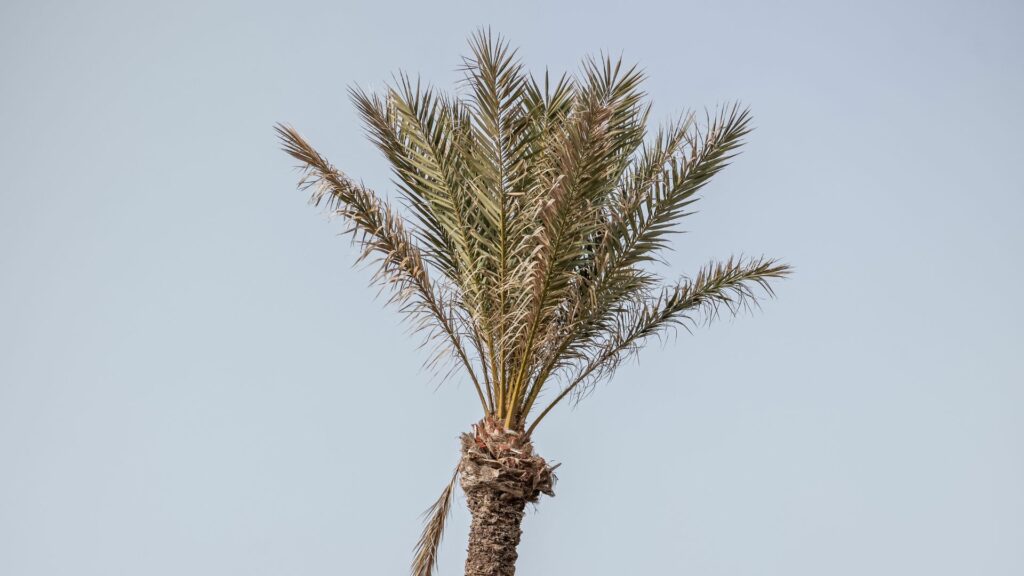Nothing provides an island feel to a space quite like a well-placed palm tree. It can, therefore, be disappointing when your tropical feature turns brown and looks nothing like the lush waving fronds you had imagined. Although palms are known as low-maintenance plants, things can go wrong, and when they do, you may wonder how to revive a palm tree.
To revive a palm, ensure it gets the right amount of water, correct soil drainage issues, and apply quality fertilizer. Increase or restrict sunlight according to the palm species. Check for pests and treat them accordingly. Do not remove discolored palm tree leaves unless they are completely dead.
Palm trees may provide a carefree vacation vibe, but trying to revive one when it looks like it is checking out can feel intimidating. Fortunately, the slender beauties are relatively uncomplicated plants, and by following a few steps, it is often possible to bring your tree back to life.
How to Revive a Palm Tree

There are 2600 species of palm, most of which grow in tropical and subtropical regions. Although they vary in size and habitat, they are usually instantly recognizable as members of the Arecaceae family of perennial trees.
The lifespan of palm trees depends on the species, but some varieties can survive between 70 to 100 years. It can be worrying to find that your showpiece palm is drying up or the leaves are turning brown before its time. Even though there are many types of palms, methods used to treat them are remarkably similar.
The first step to revive a palm tree is understanding why it may not be doing well. Recognizing the factors that could be making the plant sick is an excellent starting point in turning things around. Palm trees can die because of the following:
- Plant diseases or pests
- Too much or too little fertilizer in the soil
- Lack of nutrients
- Over or under-watering
- Unbalanced soil pH
- Unsuitable temperature for the species
- Too much or too little direct sunlight
- The use of pesticides nearby
Reviving an ailing palm is about correcting imbalances and creating optimal conditions for healthy growth. Let’s go through some tips that can help you restore your palm to its usual carefree appearance.
6 Tips to Bring a Palm Tree Back to Life
When palm tree leaves start discoloring or drying up, it is essential to turn things around as soon as possible. Even though palms have a reputation for being hardy, the sooner treatment begins, the better the odds of recovery.
Let’s go through some things you can try to revive a palm tree:
Give the Palm the Correct Amount of Water
Palms need enough water, but not too much. This may sound confusing, but too little will result in the leaves drying out, while too much can result in lethal conditions like root rot.
Potted palms are particularly susceptible to being over-loved by their owners and being watered too often. If you are guilty of being a serial waterer, it helps to add 30% sand mixture to the soil to encourage faster draining.
Treat the Palm for Diseases and Pests
Palms can become infected with a surprising number of diseases and pests. They are also susceptible to underground fungal conditions that can slowly eat away at the tree.
Many plant pests thrive in palms, but fortunately, there are ways to eliminate them before they kill the plant. Treat infested palms with insecticidal soap, horticultural oil sprays, or pyrethrin-based insecticides to eradicate insect pests.
Only Cut Away Fronds that are Completely Dead
It is natural to want to reach for the garden shears to cut unhealthy-looking leaves off plants. Pruning often improves the appearance of sickly plants. Removing foliage with brown spots or drying edges usually allows plants to focus their strength on healthy areas.
Palm trees are a little different, and fronds should be left on the plant, even if they are turning brown or becoming brittle along the edges. Removing unhealthy foliage from palms causes nutrient loss and prevents new growth from forming. Only remove fronds that are completely dead.
Add a Palm Specific Fertilizer
A plant lacking the correct nutrients is likely to be weak and susceptible to disease. Try to kick-start your dying tree by giving it a boost of fertilizer specifically formulated for palms.
Unlike regular general plant fertilizers, palm-specific varieties are usually higher in elements like boron, iron, and magnesium. Feeding palm fertilizers high in nitrogen often causes the leaves to turn yellow and look unhealthy.
Adjust the Amount of Sunlight Your Palm Receives
The stereotypical idea of tall palm trees growing on sun-drenched beaches is not necessarily what all varieties need. Many smaller palms prefer dappled or indirect bright light rather than hours of burning hot sun.
Some leaves can become sunburned if they get too much sun, while others turn brown from not getting enough sun. If your palm is in a pot, you may need to experiment and move it around to find the plant’s sweet spot.
Check that the Palm is Planted at the Right Level
Newly planted palms often go into death throws if they are planted too deep in the ground. Palms have a circular ball of roots at the bottom of the tree. The plant should only be planted deep enough to cover the root ball.
Some palm varieties are more forgiving in this regard. Mexican Fan Palms don’t mind being buried a little deeper and are an excellent option for anyone wanting to establish a row of uniform-sized feature palm trees.
How to Tell if a Palm Tree is Dead
Palms can be tricky because even though they may appear beyond hope, with the right conditions and some TLC, they often surprise everyone by sending out healthy new fronds. A dead palm tree could cause damage or injury if it falls, so check out for the following clues to know that the plant is dead.
- All the fronds have been completely brown or dry. There is no sign of new green growth on the top of the tree. To be safe, leave the palm for a week before rechecking. If nothing has changed, the plant is dead.
- There are no signs of green anywhere on the tree. Use your fingernail or a knife to scrape lightly on the trunk. If there are any hints of green, the tree is still alive.
- The crownshaft on the top of the tree has been cut off or damaged. If this section of a tree has been removed, the plant cannot be saved.
- Tapping on the outer cambium (that’s the bark) produces a hollow sound. This could be the result of a fungal disease or plant pests.
Many signs, like wilting or discolored leaves, may indicate that a palm tree is sick, but it may still be savable. If you suspect your palm tree is dead, it is often best to wait a few months. If no new growth is visible, you can be sure that the tree is dead.
Final Thoughts
No matter how bad it looks, if there is any life left in a palm tree, it is possible to bring it back to life. Simple measures like adding water or nutrients or correcting the soil drainage can cause the tree to send out fresh green fronds from the crown. Don’t give up on an unhealthy palm too soon because it may surprise you and still provide many decades of idyllic island vibes.

